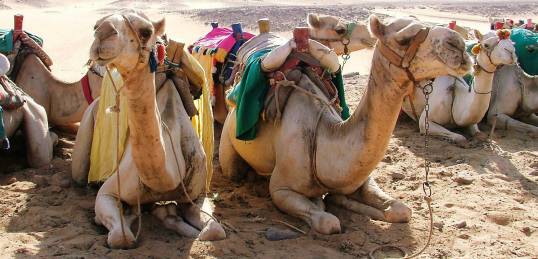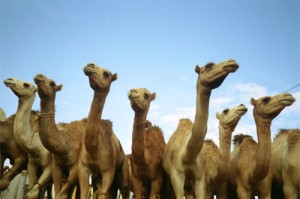Source: Click Here
Camels in Herds
The most prominent social behavior of the dromedary camel is for use in its adaptive behavior. Individual camels will congregate in large groups in order to regulate body temperature. During the summer, dromedaries gather in groups of about 20 camels so they can rest close together in order to cool off by reflecting the heat reflecting off the ground (Huffman). Herd sizes differ during various seasons, with the largest herds being found in the hottest months. Common herds tend to contain about 3 to 5 males, and anywhere from 5 to 15 females is common. Most calves are born from July to August, and yearling camels are never seen without females. There are occasionally older male camels that are found without herds, however this is not very common. Camels walk in a single file line when traveling for water, often times led by a female, he young congregating in one section, and the oldest camels in the rear. They tend to create trails leading to wells to watering areas that are about a foot wide so they can avoid any rocks or other formations that could damage their padded feet (Gautheir-Pilters and Dagg 79-80).
Mating Practices
The mating season of dromedary camels is from December to May. Herd management practices by man have greatly shaped the breeding processes of camels. In most places, humans determine the herd size for their camels, and humans castrate most males by the age of three to be able to control breeding practices. Males tend to be aggressive around females during the breeding season, even if they are castrated. Male camels in this situation can be so aggressive, they will fight to the death (Gautheir-Pilters and Dagg 80). Aside from aggressive rutting males, camels tend to be gentle creatures. Camels can tend to fight a small amount when being loaded, but overall they are not temperamental (Irwin 15-16). Male rutting camels will not only display aggressive tendencies, but also will blow air out of the soft palate (dula) to impress females, who are attracted to the scent (Irwin 26). The mating process of camels, though remaining subject to natural tendencies, is almost entirely controlled by human breeders. The curtailment of the natural process integrates the shifting of camel behavior by human convenience. It is important that humans control the breeding processes of their camels to limit herd sizes and maintain a profitable balance. This marks another facet of camel exploitation.

Source: Click Here
Source: Click Here
Resting Camels
Camels will spend about 10 hours a day grazing for food, and their grazing tendencies often include a lot of diversity of location, which aids in the ecological rejuvenation of the area in which they graze. However, this tendency does require very large grazing areas for camels. The resting tendencies of camels are another unique attribute. Camels will use their soft, padded foot to locate the softest spot for a rest. They will then drop on to their front legs, followed by heaving the rest of their body down to the ground. They rest upon their chest callus, which is a hard area on the camel’s chest that allows it to rest its vast body weight on the chest without damage. As mentioned previously, camels rest in contact with each other to stay cool, and during the day camels will rest facing the sun so that their bodies absorb minimal amounts of heat. Their chosen locations of rest often remain the same for each herd, and camels can locate these spots time after time by smelling the area (Irwin 24-26).

Source: Click Here
Odd Behavior
Dromedaries have been known to display some strange social behaviors. They tend to bite other camels and sometimes humans without using teeth. Camels will also stamp their feet and sprint short bursts when they’re angry, and will spit cud when they’re excited or injured (“Dromedary Camel, Camelus dromedarius”). In fact, camels also spit as a means of establishing hierarchy, often times while feeding, to let lower-ranking members of the herd understand their place. This spit has a very powerful odor. Females can also spit to chase away overly persistent males, however it doesn’t smell as foul as the males’ spit (Anitei). Camels tend to vocalize with a bleat that’s used to find individuals outside of the groups, and also the gurgling sounds created by males during breeding. Occasionally, male camels will make a whistling noise used to threaten by grinding their teeth (Huffman). Take a look at this unhappy camel.

3 Responses to Ethology